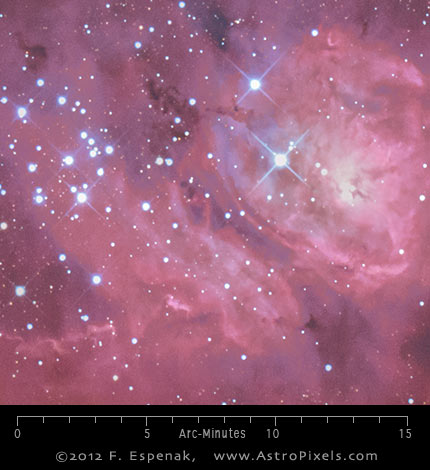
M8 - Lagoon Nebula
Messier 8 or M8 (also designated NGC 6523) is a nebula and star cluster in the constellation Sagittarius. It has an apparent visual magnitude of 6 and its angular diameter is 90x40 arc-minutes. M8 lies at an estimated distance of 5200 light years. The Equinox 2000 coordinates are RA= 18h 03.8m, Dec= -24° 23´ which makes M8 best seen during the summer. The Messier Summer Star Chart shows the position of all Messier objects visible during that season. As one of the more famous objects in the Messier Catalog, it is commonly known as the Lagoon Nebula.
The image above shows the uncropped view of M8 through the ASA N12 Corrected Newtonian Astrograph (North is up). A 2x enlargement of this image appears to the right.
For wider view of this object using the Takahashi E-180 Astrograph, see M8 (TAK E-180) .
The Lagoon Nebula contains a number of interesting objects known as Bok globules, These are dark, collapsing clouds of protostellar material, many of which were catalogued by E. E. Barnard. A tornado-like structure is associated with one of the hot O-type stars due to the ultraviolet radiation it emits. The Hourglass Nebula is another unique structure that lies at the center of M8 where star formation is presently in progress.
In spite of its inclusion in the Messier Catalog, this diffuse nebula and star cluster were actually discovered by J. Flamsteed in 1680. According to Kharchenko et al. (2005), the distance of M8 is 4310 light years and its diameter is 9 light years. It contains over 130 stars and its estimated age is 2.3 million years.
For more information, see the Messier Catalog as well as specific entries for M8 in Wikipedia and SEDS.
Messier's Description of M8
May 23, 1764
`A cluster which appears in the shape of a nebula when observed with an
simple refractor of 3 feet; but with an excellent instrument one
perceives nothing but a large quantity of small [faint] stars; near this
cluster is a fairly bright star, surrounded by a very faint glow: this the
ninth star of Sagittarius, of seventh magnitude, according to
Flamsteed [9 Sgr]: this cluster appears in elongated shape, which extends
from North-East to South-West, between the arc of Sagittarius and the foot
of Ophiuchus.
(Diam. 30')'
Technical Details
- Object: M8
- Other Names: NGC 6523, Lagoon Nebula
- Object Type: nebula and star cluster
- Object Data: Apparent Magnitude = 6, Angular Size = 90x40 arc-minutes
- Object Position (Equinox 2000): RA= 18h 03.8m, Dec= -24° 23´, Constellation = Sagittarius
- Date/Time: 2012 Oct 06 at 02:48 UTC
- Location: Bifrost Astronomical Observatory, Portal, AZ
- Mount: Astro-Physics 1200GTO
- Telescope: ASA N12 Corrected Newtonian Astrograph
- Camera: Canon EOS 550D (Rebel T2i) (modified with a Baader UV/IR filter)
- Field of View: 71.0 x 47.4 arc-minutes at 0.82 arc-sec/pixel (web version: 4.6 arc-sec/pixel)
- Exposure: 1 x 300s, f/3.6, ISO 800
- File Name: M8-A01w.jpg
- Processing (Adobe Camera Raw): Noise Reduction, White Balance, Whites and Blacks Adjustments
- Processing (Photoshop CS6): Flat Field Subtraction, Curves, Masking, HDR Toning, Noise Reduction
- Original Image Size: 3454 × 5179 pixels (17.9 MP); 11.5" x 17.3" @ 300 dpi
- Rights: Copyright 2012 by Fred Espenak. All Rights Reserved. See: Image Licensing.
